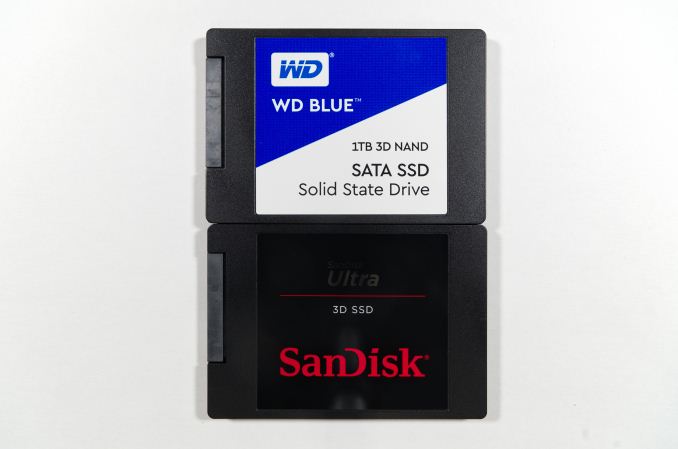One Design, Two Products: The SanDisk Ultra 3D (1TB) and WD Blue 3D (1TB) SSD Reviews, with BiCS 3D NAND
by Billy Tallis on September 14, 2017 9:00 AM ESTConclusion
Compared to last year's WD Blue that used planar TLC NAND flash, the new WD Blue 3D NAND and SanDisk Ultra 3D perform much better on tests where the older drive was weakest. At lower queue depths where the bandwidth of the SATA link was not a bottleneck, the new SSDs delivered significantly better random read and write performance than their predecessors. But the SATA bus has limited how much of a peak improvement 3D NAND could make for the raw performance of Western Digital's SSDs.
Compared to the competing drives on the market today, the new WD Blue 3D NAND and SanDisk Ultra 3D have the performance that is expected of a mainstream SATA SSD. On most real-world workloads, there's no noticeable performance difference between the Ultra 3D and the Samsung 850 EVO. The Ultra 3D also handles being full better than most TLC drives, and does not show the spike in latency that several drives like the Crucial MX300 exhibit. Overall, it is clear that SanDisk is still very good at managing TLC flash and implementing SLC caching in a way that has almost no downsides.
The switch to 3D NAND also brings substantial power savings to the WD Blue 3D NAND and SanDisk Ultra 3D. Idle power is unchanged from the previous generation of drives, but power draw under load is much lower.
| 240-275GB | 480-525GB | 960-1050GB | 2TB | |
| SanDisk Ultra 3D | $89.99 (36¢/GB) | $149.99 (30¢/GB) | $284.99 (29¢/GB) | $549.99 (28¢/GB) |
| WD Blue 3D NAND | $94.99 (38¢/GB) | $164.99 (33¢/GB) | $309.99 (31¢/GB) | $619.99 (31¢/GB) |
| Crucial BX300 | $89.99 (38¢/GB) | $149.99 (31¢/GB) | ||
| Crucial MX300 | $92.99 (34¢/GB) | $149.99 (29¢/GB) | $284.47 (27¢/GB) | $544.62 (27¢/GB) |
| ADATA SU800 | $91.99 (36¢/GB) | $154.99 (30¢/GB) | $269.99 (27¢/GB) | |
| Intel SSD 545s | $99.99 (39¢/GB) | $209.00 (41¢/GB) | ||
| Samsung 850 PRO | $104.99 (41¢/GB) | $209.09 (41¢/GB) | $406.00 (40¢/GB) | $859.99 (42¢/GB) |
| Samsung 850 EVO | $89.99 (36¢/GB) | $147.99 (30¢/GB) | $327.00 (33¢/GB) | $697.99 (35¢/GB) |
Current pricing for the Western Digital SSDs is a bit odd. The WD Blue 3D NAND is more expensive than the SanDisk Ultra 3D by several cents per GB despite the two products being the same under the sticker. The only reason to go with the WD Blue 3D NAND at the moment is for the M.2 version, since the SanDisk Ultra 3D is only available in the 2.5" form factor.
The SanDisk Ultra 3D is priced in between the Crucial MX300 and the Samsung 850 EVO. This matches their relative performance. The performance advantage of the 850 EVO is quite small for most real-world workloads, so its premium mostly buys you a longer warranty and the proven maturity of a product that has been on the market for a long time. If your workload is heavy enough for the difference between the 850 EVO and the Ultra 3D to matter, you should probably be shopping for a NVMe SSD instead of SATA. Meanwhile, the SanDisk Ultra 3D offers higher write endurance ratings and lower power consumption for a slightly lower price. The Ultra 3D makes more sense for most consumers.
Between the SanDisk Ultra 3D and the Crucial MX300, the Ultra 3D should be preferred for heavier workloads. The MX300 will get you an extra 25 or 50GB for the same price, but if you fill up the drive enough for that slightly higher capacity to come into play, the Ultra 3D will perform better. The MX300 still has the advantage in power efficiency and is the better pick for mobile use.
With a good balance of price, performance and power efficiency, the SanDisk Ultra 3D is an easy recommendation.













52 Comments
View All Comments
MajGenRelativity - Thursday, September 14, 2017 - link
Looks like a good drive to keep in mind. Congratulations to WD and SanDisk on making a product worthy of challenging the 850 Evo. Good to see the rest of the market FINALLY catching up!nathanddrews - Thursday, September 14, 2017 - link
Knowing that SATA is just about completely tapped at this point, it would just be nice if we could get these drives down to the $0.10/GB range.MajGenRelativity - Thursday, September 14, 2017 - link
Unfortunately, that won't happen while we're in the middle of a NAND shortage/price fixing epidemicDanNeely - Thursday, September 14, 2017 - link
Agreed. I'm hoping that by next year the large scale switch over from planar to 3d nand will be complete and the supply situation will be less squeezed.MajGenRelativity - Thursday, September 14, 2017 - link
Yep. I hope DRAM prices go down tooDanNeely - Thursday, September 14, 2017 - link
Same, although a shortage caused by rising demand is at least a good problem to have after years of the consumer PCs decline dragging the industry down.MajGenRelativity - Thursday, September 14, 2017 - link
That's true, assuming the "shortage" is caused by rising demand. I have no proof either way, so you quite well could be right.melgross - Wednesday, September 20, 2017 - link
Much of it is coming from increasing smartphone and tablet storage. For example, Apple now has either 64GB or 256GB for their phones, and up to 512GB for the Pro tablets. Those are pretty large numbers, and along with some Android models, are sucking a lot of NAND and RAM out of the market.smilingcrow - Thursday, September 14, 2017 - link
The demand is coming from other areas not PCs and that's only half of it.The other is that they have kept supply low so not to get into the same over supply issue that they have had before.
The very low RAM prices were unsustainable due to massive losses but not sure if NAND has ever been sold below cost.
MajGenRelativity - Thursday, September 14, 2017 - link
Ah